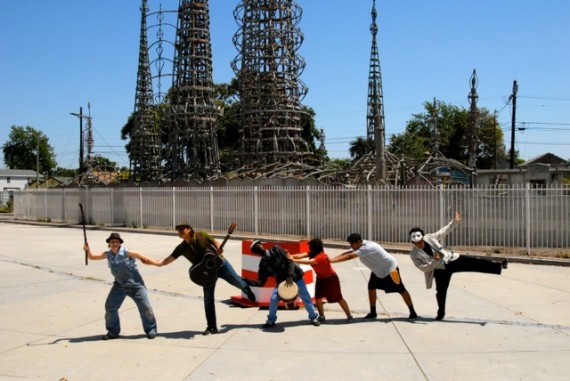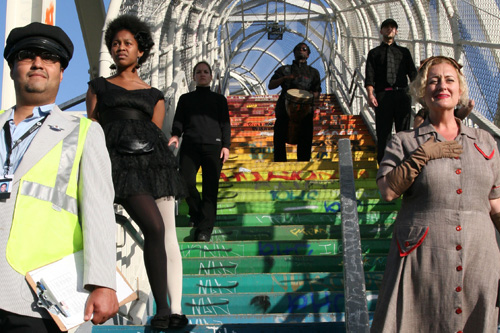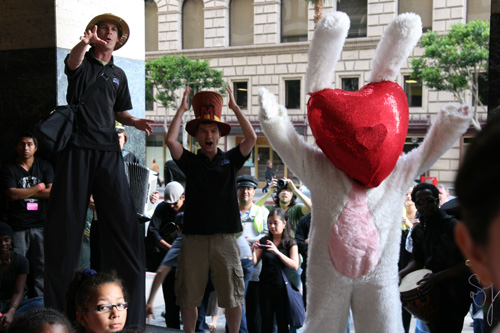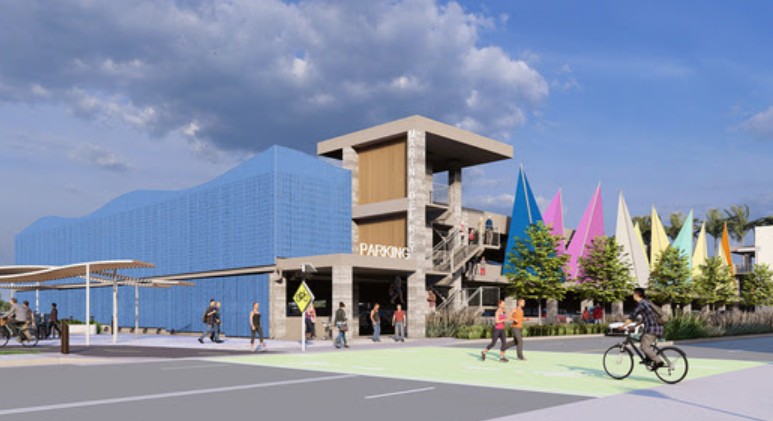YOU CAN SEE GOATS from the Blue Line, Guillermo Avilés-Rodríguez, Artistic Director of the Watts Village Theater Company (WVTC), told me excitedly.
He knows this because “goats” were one of the items that participants had to spot for Metro Bingo, a game played as part of the immersive theater experience that is Meet Me @ Metro (MM@M).
Now in its third year, MM@M is a theatrical journey on Los Angeles' Metro Rail featuring unique, site-specific performances from local theater companies and performers, curated by the WVTC. Patrons board the Metro at one location and are enveloped in colorful and inspiring theater, music, dance, puppetry, spectacle, and even food, that help them explore the historical, cultural, and artistic significance of the communities along the route.
The Blue Line served as host for the first two years, giving theater-goers a new perspective on the communities of South L.A. This August, they will be “Uncovering Los Angeles' Hidden Treasures,” embarking at Union Station and heading out to East L.A. on the Gold Line.
Eventually, Avilés-Rodríguez hopes, there will be performances running on multiple lines at once, giving patrons the option of exploring several communities in one day. The creation of that kind of only-in-L.A. experience had been the original concept, he said, but "as is typical when you do something for the first time, Metro was very concerned about, well...everything.”
Why Metro?
Which brings up the question of “Why Metro?” Surely the unpredictability of the medium and its passengers – the performances would not halt or disrupt service – would raise the risk of things going awry?
For Avilés-Rodríguez, Metro represents opportunities for synergy between art, transit, and sustainability. It's a way to bring theater to people and is far more likely to get them to ride transit than billboard advertisements. And it is an engaging way to introduce communities to each other via the common vehicle that traverses them.
But it is also more than that: the unpredictability feeds the performances.
“The non-scripted moments are really the point,” he explained.
With everything in flux, the boundaries between performers and patrons and passengers become more permeable. A patron doesn't know how far the “theater” extends into the space. Maybe the woman selling churros is part of the show. Maybe she isn't. Whether or not she is doesn't actually matter. What matters is that the space is transformed for participants, giving them opportunities to relate to it in a different way.
That transformation, believes Avilés-Rodríguez, is key to changing people's perceptions of communities and creating possibilities for new interactions with a place and its inhabitants.
“We're isolated – and it is not always our choice,” he said. “We exist together but we don't live with each other.”
Theater as "Verb"
The isolation is most pressing for those south of the 10 Freeway. When people stopped coming to Watts shows – or never came at all -- because of concerns about safety or the belief that good theater could not be found there, he said, the WVTC decided to take a new approach.
“We said, 'We'll bring you and you'll be part of the show. You'll get on in a very safe place, Union Station. And you'll ride Metro – that's safe, right? And you'll get off and go a little walk. And you'll have a group and it's safe.'”
At the same time they would be introducing people to new parts of South L.A., youth from Watts who had never traveled more than a 10-mile radius beyond their own community would have a chance to have their horizons broadened in a safe environment. These two groups would cross paths as part of the production in ways that could begin to break down barriers between them. All the while, their interactions would enrich the art.
"The diversity of our audiences makes us stronger,” said Avilés-Rodríguez.
Ensuring that the audience is diverse is not always easy, however. Until now, the majority of patrons have not been from South L.A., something which Avilés-Rodríguez acknowledged was frustrating but felt was all the more reason to continue to perform work in public spaces.
When they stage their work Riot/Rebellion on the 1965 Watts Riots, for example, they will shut down the intersection of Avalon and 116th Sts., where it all began.
It has to be in that location, he said. The people that lived those events, contributed their stories to the scriptwriters, and need to see that play will be able to peek out of their windows or come with their whole families, sharing their history across generations. It's important, too, he said, because the “disease” which led to the riots in the first place has not been dealt with -- only the symptoms have been addressed. The play will offer the opportunity for residents to revisit those concerns and have spontaneous and frank public dialogue around them in the street as it is being staged.
“Violence and mayhem stopped everything in that intersection in 1965,” he said, “but a different kind of drama is stopping everything this time around.” The spectacle will open the door for actors and theater-goers alike to inject the space with new meaning.
It comes down to understanding theater as "verb," where the value comes from the involvement of the community in the staging and overall composition of an entire, participatory experience. That kind of thing can't happen in a traditional brick-and-mortar theater in the same way it can happen in a public space, Avilés-Rodríguez believes.
Instead, he said, for theater to be vibrant and relevant, it has to be accessible and "it needs you to participate in the making of it.”
Guillermo Avilés-Rodríguez is Artistic Director of the WVTC. For more information about them and upcoming performances please visit: http://wattsvillagetheatercompany.org/










